Adhering to a ketogenic diet involves monitoring the intake of carbohydrates meticulously to maintain a state of ketosis, where the body burns fat for fuel instead of glucose. This shift in metabolism is achieved through a diet rich in healthy fats and low in carbs.
Sauces and dressings, while often overlooked, can be pivotal in a ketogenic lifestyle, as they can either support or undermine the strict macronutrient ratios required for ketosis. Therefore, it’s crucial for those following a keto diet to be cognizant of the ingredients in their condiments.
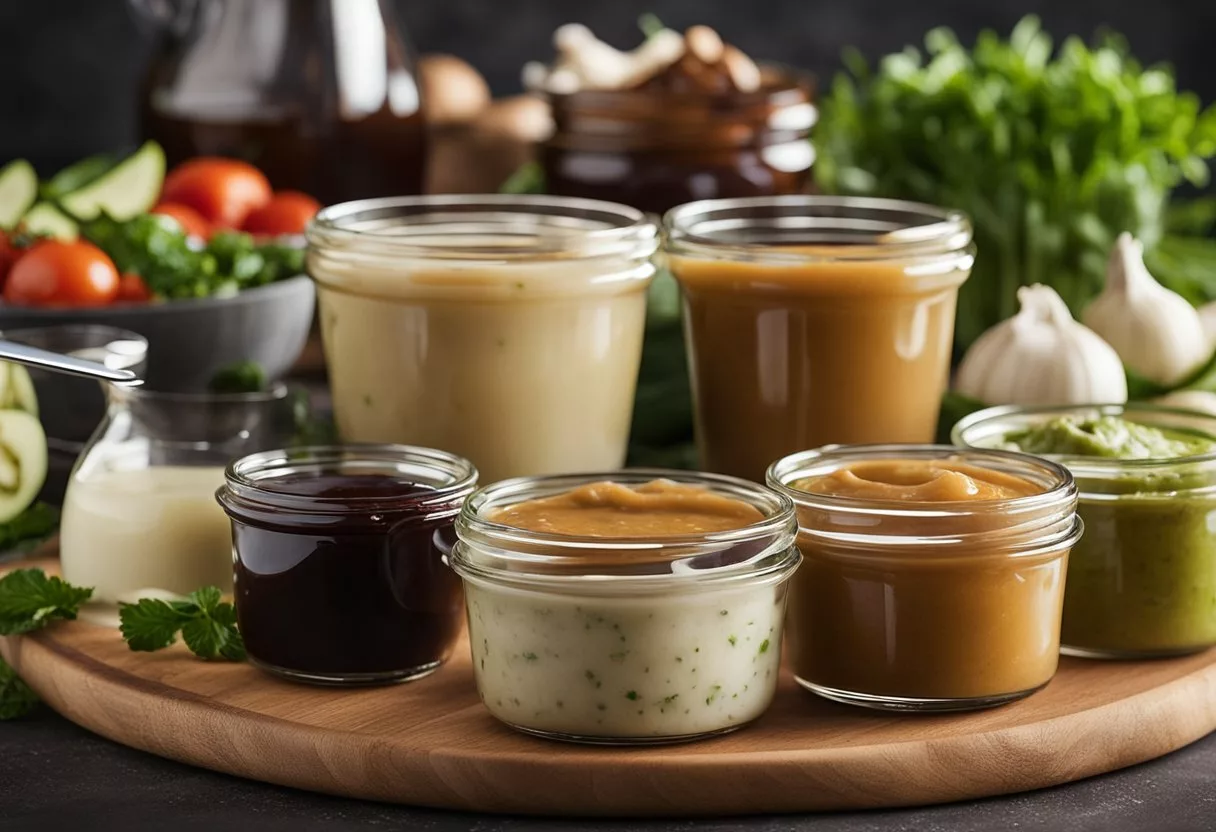
Creating keto-friendly sauces and dressings is a balance of avoiding sugars and starches while incorporating fats such as avocados, coconut oil, and certain dairy products. When done correctly, these condiments can not only make low-carb meals more enjoyable but also help sustain the necessary fat intake for ketosis.
For those who prefer convenience, there are store-bought options available that align with the ketogenic diet, but attention to labels is imperative. Many choose to customize their own sauces and dressings at home, where they can control the ingredients and tailor flavors to personal preferences.
Key Takeaways
- A keto diet requires careful consideration of sauces and dressings to maintain ketosis.
- Healthy fats and low-carb ingredients are essential in keto-friendly condiment recipes.
- Customization and label scrutiny are key for incorporating condiments into a ketogenic lifestyle.
Understanding Keto Diet Basics
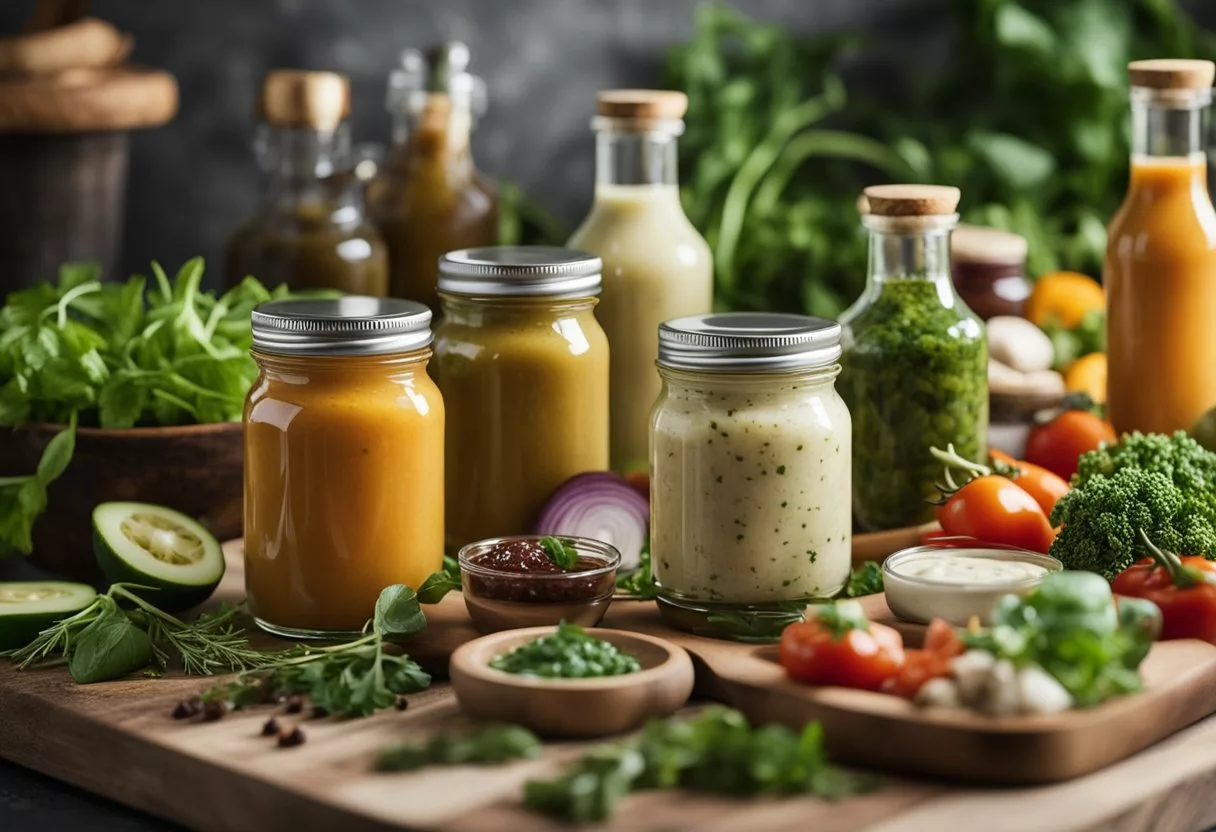
In adopting a ketogenic lifestyle, individuals prioritize high-fat, low-carbohydrate foods to stimulate the body to enter a state of ketosis.
Principles of Ketogenic Diet
The ketogenic diet is structured around a high-fat, low-carbohydrate formula, where the body switches its main energy source from glucose to ketones, produced by the liver from stored fat. Typically, this diet consists of approximately 70%-80% fat, 20%-25% protein, and 5%-10% carbohydrates. By reducing carbohydrate intake drastically, the ketogenic diet encourages the body to become exceptionally efficient at burning fat for energy.
| Macronutrients | Percentage of Daily Intake |
|---|---|
| Fat | 70%-80% |
| Protein | 20%-25% |
| Carbohydrates | 5%-10% |
Benefits of Keto for Health
Research suggests that the ketogenic diet may offer several health benefits. Notably, individuals often pursue a ketogenic diet for weight loss, as it can help to reduce appetite and improve metabolism. The ketogenic diet is also associated with improvements in blood sugar control, which can be especially beneficial for those managing diabetes. Additionally, some studies indicate potential cardiovascular benefits due to increased levels of ‘good’ HDL cholesterol. It is vital for individuals to approach the ketogenic diet under the guidance of a healthcare professional to ensure that it aligns with their specific health needs.
The Role of Sauces and Dressings in Keto
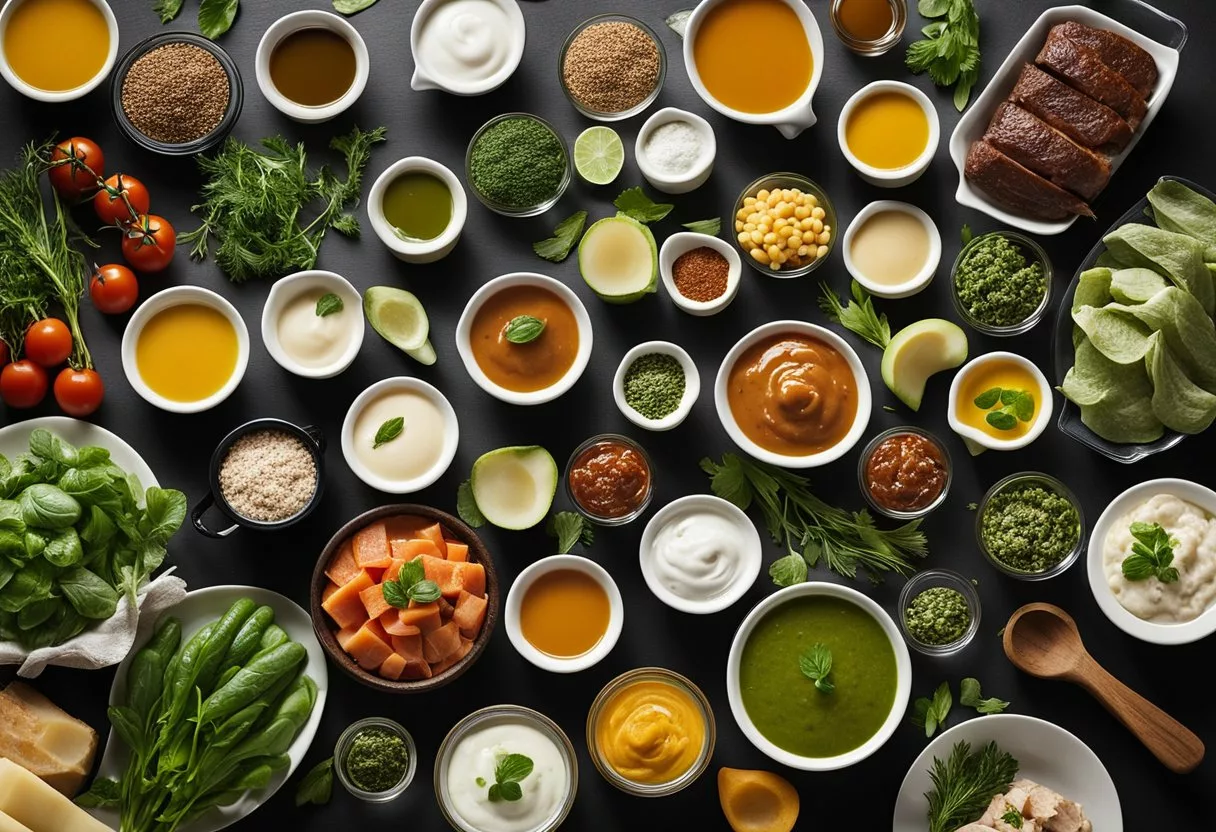
Sauces and dressings enhance the flavor of meals, which can be especially significant for individuals following a ketogenic diet to maintain variety and enjoyment in their eating habits.
Nutritional Considerations
When incorporating sauces and dressings into a ketogenic diet, attention must be paid to the nutritional content. The ideal keto-friendly sauces and dressings have high fat, moderate protein, and low carbohydrate content. This balances the macronutrient requirements of the diet while ensuring flavors are not compromised.
- Carbohydrates: Keto sauces and dressings should be low in carbohydrates. Limiting carbs is crucial as the dietary goal is to enter a state of ketosis.
- Sugar-Free: Products must ideally be sugar-free or use natural low-carb sweeteners.
- Fats: They should contain healthy fats, as fats are leveraged for energy in the absence of high carbs.
Common Pitfalls to Avoid
Many commercial sauces and dressings are laden with sugars and high-carb ingredients. One must scrutinize labels and ingredient lists to ensure they align with keto principles.
- Hidden Sugars: Avoid dressings and sauces with added sugars or those that list high-carb ingredients like honey, agave, or corn syrup.
- Thickening Agents: Many thickeners can increase carb content. Look for options that use keto-friendly ingredients for thickening.
- Homemade vs. Store-Bought: Store-bought options can contain preservatives and unwanted additives. Homemade keto dressings and sauces can be tailored to one’s specific dietary needs.
By carefully selecting or preparing keto-friendly condiments, one can enjoy a variety of flavorful dishes while adhering to the ketogenic lifestyle.
Essential Ingredients for Keto-Friendly Sauces
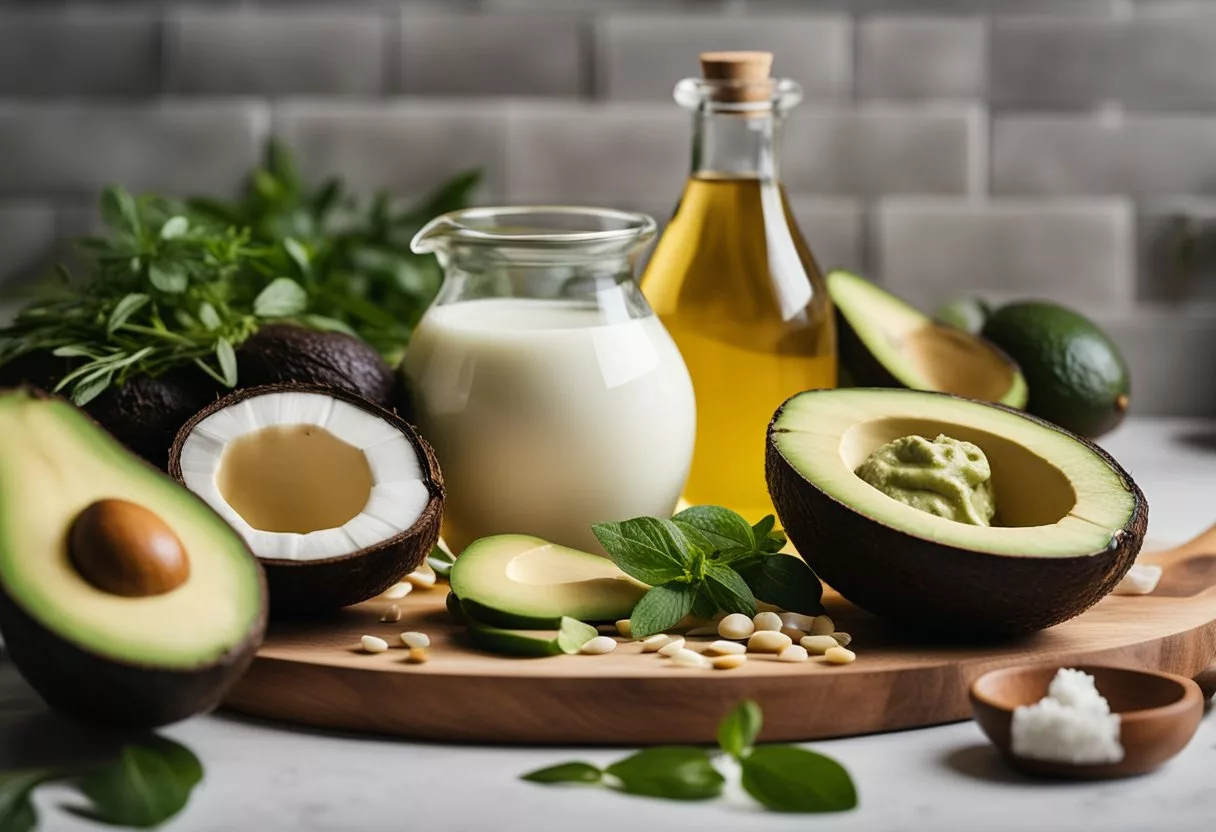
Creating keto-friendly sauces hinges on using ingredients that are low in carbohydrates but rich in flavors and the right textures. The ideal components should enhance taste without adding sugars or unnecessary carbs.
Healthy Oils and Fats
The base for many keto sauces begins with healthy oils and fats. These ingredients are crucial as they provide a creamy texture and richness, making them perfect for a low-carb diet.
- Olive Oil: A staple in keto cooking, extra virgin olive oil is prized for its flavor and health benefits.
- Avocado Oil: With a high smoke point and mild taste, avocado oil is versatile for both cooking and in raw sauces.
- Coconut Cream: A dairy-free option that offers a thick, creamy texture for various sauces.
- Heavy Whipping Cream: Ideal for creating a rich consistency in sauces such as Alfredo, without adding carbs.
Flavor Enhancers without Carbs
Essential to any sauce is its flavor profile. Flavor enhancers without carbs ensure that the sauce is keto-friendly while still being delicious.
- Garlic: Adds a punch of flavor to any sauce with minimal carbs.
- Vinegar: Including apple cider, red wine, and balsamic (in moderation), it provides a tangy accent.
| Type of Vinegar | Keto Usage |
|---|---|
| Apple Cider | Perfect for dressings and marinades |
| Red Wine | Adds depth to meat-based and tomato sauces |
| Balsamic | Use sparingly due to higher carb content |
- Mustard and Mayo: Both are excellent condiments that can be used alone or as a base for other sauces, adding creaminess and zing without the carbs.
Keto Thickeners
Thickening agents that are low in carbs are essential for achieving the desired consistency without using traditional flour or cornstarch.
- Cream Cheese: Adds a rich and smooth thickness to sauces, and it’s a staple in dairy-based keto recipes.
- Dairy Products: Heavy cream and high-fat cheeses are excellent for thickening while adding flavor.
- Dairy-Free Options: For those avoiding dairy, alternatives like almond flour or xanthan gum can serve as thickeners.
Natural ingredients should always be prioritized in a keto diet; opting for organic and non-processed versions of these essential ingredients can help maintain the health benefits and purity of the diet.
Creating Keto-Friendly Dressings

Crafting dressings that align with a ketogenic diet means focusing on low-carb, high-fat ingredients while avoiding added sugars and excessive carbohydrates.
Homemade Salad Dressings
One can easily prepare keto salad dressings at home using basic ingredients like apple cider vinegar or red wine vinegar, along with lemon juice for a tangy profile. Adhering to the keto principle, these dressings prioritize fat content through the incorporation of olive oil or avocado oil.
- Ranch Dressing: Combine sour cream, mayonnaise, fresh dill, garlic powder, and a dash of lemon juice or vinegar to create a rich, flavorful ranch dressing suitable for the ketogenic diet.
- Italian Dressing: Mix red wine vinegar, olive oil, dijon mustard, and Italian herbs like oregano and basil with a pinch of salt and pepper.
Creamy Keto Dressings
Creamy dressings bring a luscious and rich consistency to salads without compromising ketosis when made with keto-friendly ingredients.
- Blue Cheese Dressing: Start with a base of mayonnaise and sour cream, then crumble in blue cheese, and flavor with a splash of apple cider vinegar or lemon juice.
- Caesar Dressing: Emulsify olive oil with lemon juice, crushed garlic, dijon mustard, and finely grated parmesan cheese for a decadent Caesar dressing.
Vinaigrettes and Light Options
Vinaigrettes offer a lighter dressing choice that can still be crafted to be keto-compatible by carefully selecting the right types of vinegar and oil.
- Simple Vinaigrette: Whisk together olive oil and vinegar in a 3-to-1 ratio, adding dijon mustard and optional keto-friendly sweeteners for balance.
- Herb Infused Vinaigrette: Infuse olive oil with herbs like rosemary or thyme and combine with apple cider vinegar for a burst of flavor.
Crafting Keto-Compatible Sauces

Crafting sauces suitable for a ketogenic diet involves selecting low-carb ingredients that enhance flavor without adding unwanted sugars. From spice-infused concoctions to creamy toppings and subtly flavored marinades, keto-friendly sauces can transform the simplest meal into a culinary delight without compromising dietary goals.
Spice-Infused Sauces
Spice-infused keto sauces rely on the natural flavors and aromas of herbs and spices to deliver rich taste profiles. An example is a keto-friendly BBQ sauce, which may use alternatives like erythritol or stevia to achieve the traditional sweet tanginess without the sugar. For homemade chimichurri, one can combine parsley, oregano, garlic, vinegar, and olive oil for a punchy, herby sauce perfect for drizzling over grilled meats.
Cream-Based Sauces
Cream-based sauces provide a satiating, fatty component crucial to the ketogenic diet. When creating a keto alfredo sauce, one can use heavy cream, butter, and Parmesan cheese, focusing on avoiding flour or cornstarch as thickeners. Hollandaise sauce is another keto-friendly choice, made with egg yolks, melted butter, and lemon juice for a creamy, tangy finish.
Keto Marinades
Keto marinades enhance the flavors of proteins without adding excessive carbs. A simple marinade might combine olive oil, vinegar, spices like ginger, and sugar-free seasonings. It’s important that sweet flavors typically achieved through sugar or honey are instead created using keto-approved sweeteners. Sugar-free ketchup can serve as a base for a burger sauce or a spaghetti sauce, mixed with herbs and aromatics. Creating a keto marinara sauce involves using tomatoes judiciously and enhancing the sauce with basil pesto for additional fat and flavor.
Incorporating Keto Sauces and Dressings into Meals

In the context of a ketogenic diet, sauces and dressings have the power to transform simple ingredients into appetizing dishes. They add not only flavor but also needed fats to sustain the diet’s macronutrient requirements.
Salad Creation with Keto Dressings
For a satisfying and nutrient-rich meal, individuals on a ketogenic diet can pair leafy greens and non-starchy vegetables with keto salad dressings. Opting for high-fat dressings is key, as they maintain ketosis and provide energy.
- Keto Caesar: Utilizes mayonnaise, anchovy, garlic, and Parmesan.
- Ranch: Combines sour cream, mayonnaise, and herbs like dill and parsley.
Incorporating a variety of vegetables such as spinach, arugula, and kale enhances the nutritional profile and complements the bold flavors of these dressings.
Enhancing Proteins with Sauces
Proteins are foundational in a keto diet and sauces can significantly elevate their taste.
- Chicken: A staple protein that pairs well with a keto buffalo sauce made from a keto-friendly hot sauce mixed with butter.
- Burgers: Can be livened up with a sugar-free keto burger sauce, often a blend of mayonnaise, mustard, and spices.
When preparing protein sources, the use of sauces should be balanced to ensure they enhance rather than overpower the natural flavors.
Keto-Friendly Side Dishes
Keto sauces can also be a delightful addition to side dishes, bringing them to the forefront of a meal.
- Roasted Vegetables: Drizzle olive oil-based pesto or aioli to enrich the taste.
- Zucchini Noodles (Zoodles): Toss in a homemade Alfredo sauce, crafted with heavy cream, butter, and Parmesan.
Such pairings engage the palate while adhering to keto principles, keeping the overall carbohydrate count low and satisfaction high.
Tips for Choosing Store-Bought Keto Options
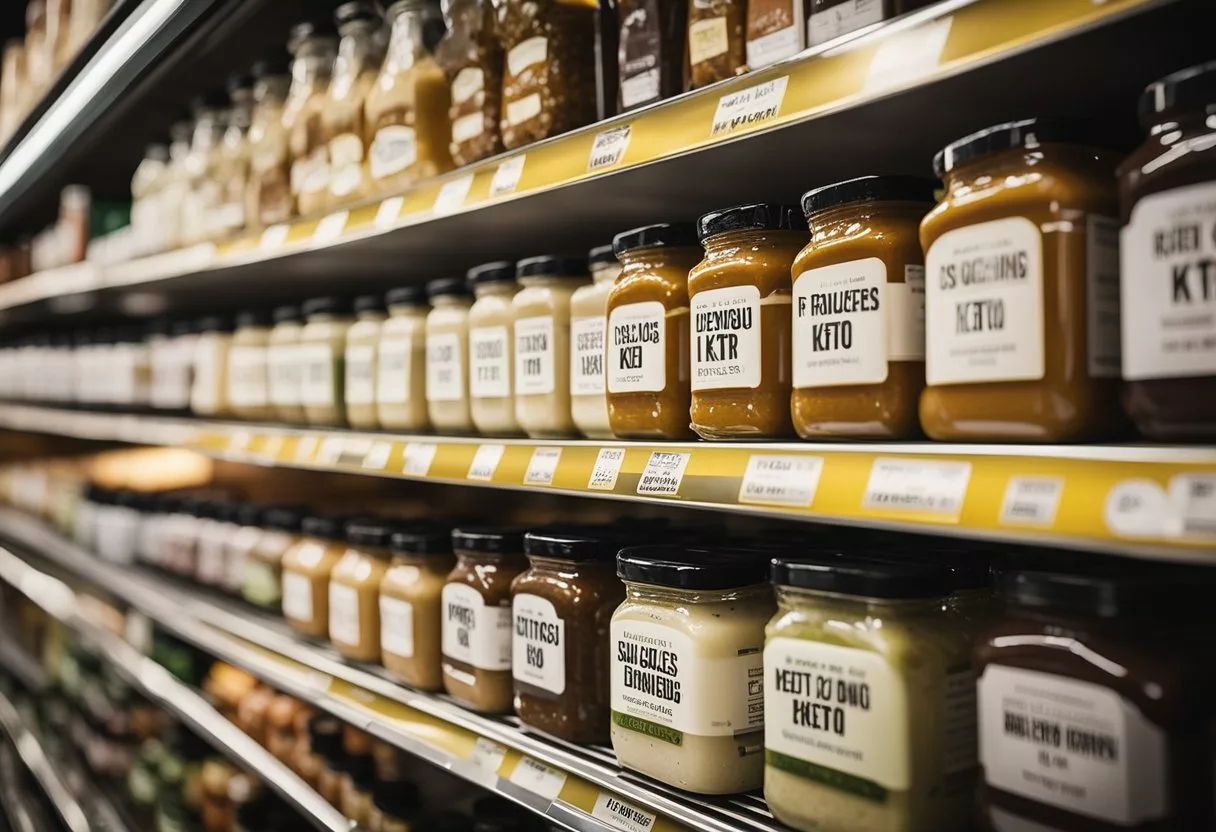
Selecting the right store-bought keto options requires vigilance, as labels can sometimes be misleading. It is important to focus on low-carb, healthy, sugar-free products to maintain a ketogenic diet.
Reading Labels for Hidden Carbs
When evaluating store-bought dressings and sauces, one must meticulously scan ingredient lists. Hidden carbs can appear under different names like dextrose, maltodextrin, or corn syrup. A rule of thumb is to look for products with no added sugars and carb content of less than 5 grams per serving.
- Watch for sugar synonyms: Maltose, sucrose, and fructose are indicators of added sugars.
- Inspect serving sizes: Companies may list a smaller serving size to appear low-carb.
- Seek fiber content: High fiber can indicate a more wholesome product with lower net carbs.
Recommended Brands and Products
Some brands have aligned with keto dietary requirements and offer convenient, health-conscious choices. For example, Rao’s sauce is noted for having a low net carb count and keto-friendly ingredients like tomatoes, olive oil, and spices.
- Keto Dressings: Look for options such as ranch or Caesar that have no added sugar and are made with healthy fats.
- Keto Mayo: Mayo is inherently low-carb, but some brands add sugar. Choose variants that use simple ingredients like eggs, vinegar, and mustard.
- Sugar-Free Options: They use substitutes like stevia or erythritol, which are more keto-friendly than artificial sweeteners.
Customizing Keto Sauces and Dressings
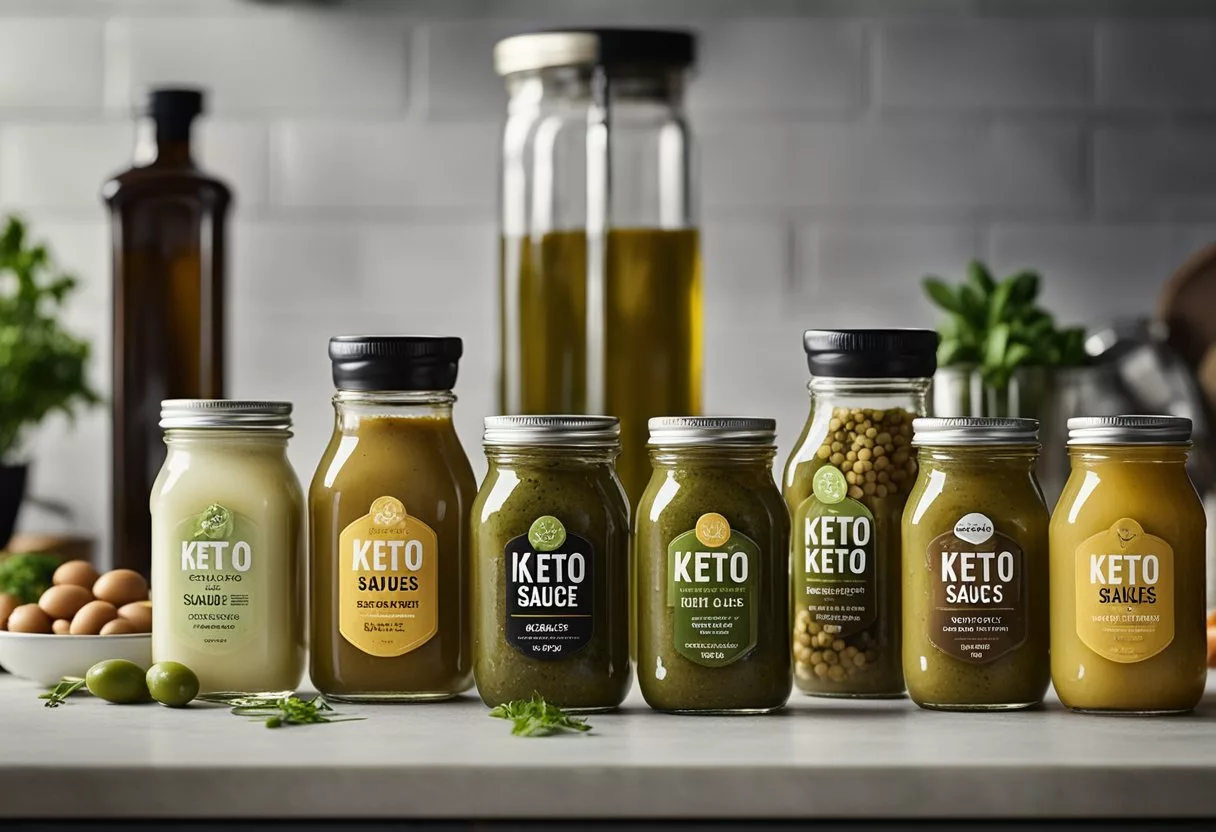
Creating personalized keto-friendly sauces and dressings allows individuals to enhance their meals while adhering to a ketogenic lifestyle. By adjusting recipes to individual tastes and experimenting with various ingredients, one can craft condiments that not only meet dietary requirements but also satisfy flavor preferences.
Modifying Recipes to Taste
When adapting sauce and dressing recipes, the key is to balance flavors while maintaining a low-carbohydrate profile. For a tangy kick, vinegar varieties such as apple cider, white, and red wine can be used sparingly. Enhancing the taste with spices—such as onion powder, garlic powder, and chives—adds depth without contributing extra carbs. Citrus, like lime and lemon juice, offers a fresh zing and can be included in moderation to keep the carb count in check.
Example Recipe Adjustments:
- Creamy Keto Dressing:
- Start with mayonnaise as a base.
- Add apple cider vinegar for tanginess.
- Mix in garlic powder and chives for a subtle, aromatic flavor.
- Spicy Keto Sauce:
- Combine a keto-friendly hot sauce with lime juice.
- Stir in onion powder for savoriness.
- Balance with a touch of keto sweetener if desired.
Creating Signature Keto Condiments
Individuals can create signature keto condiments by utilizing ingredients that are naturally low in carbohydrates. Cucumber can serve as a refreshing base for relishes and tzatziki-style sauces. Soy sauce and Worcestershire sauce, when chosen in their low-sodium and sugar-free versions, can be included in small amounts to develop distinctive flavors. Parmesan cheese lends a savory, umami quality to dressings, and fresh herbs such as cilantro impart an aromatic dimension. Experimenting with these components allows one to develop unique sauces and dressings tailored to their keto lifestyle.
Ingredient Combination Table:
| Base Ingredient | Flavor Enhancer | Herbs/Spices | Use Case |
|---|---|---|---|
| Mayonnaise | Vinegar | Garlic Powder, Onion Powder | Salad Dressings |
| Sour Cream | Lemon Juice | Chives, Cilantro | Dips & Spreads |
| Olive Oil | Soy Sauce (Low-Sodium) | Crushed Pepper | Marinades |
Short, descriptive sentences and clearly formatted tables and lists facilitate the understanding of how to customize keto sauces and dressings to individual preferences while maintaining dietary compliance.
Frequently Asked Questions
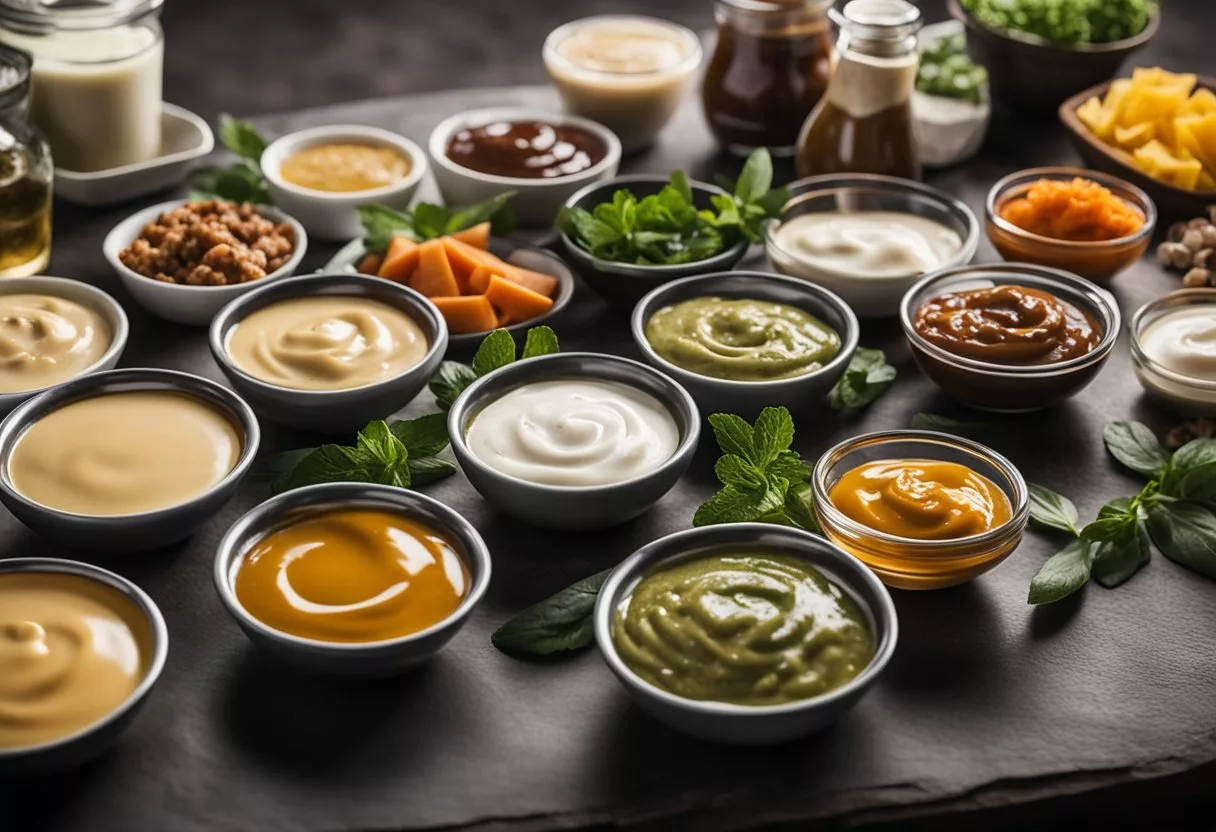
Navigating the world of ketogenic condiments can be complex. These FAQs aim to demystify which sauces and dressings are keto-friendly, and offer advice on incorporating them into your ketogenic diet.
What types of condiments can be included in a ketogenic diet plan?
Individuals on a ketogenic diet can include a variety of low-carb condiments such as mayonnaise, yellow mustard, Dijon mustard, hot sauce, and Worcestershire sauce. It’s vital to check for added sugars and carbs in the ingredients list.
Can mustard be considered a suitable condiment for those following a keto diet?
Yes, mustard is typically suitable for those on a keto diet as it is low in carbohydrates. Yellow, Dijon, and whole-grain mustards are all generally acceptable, but one should always check the label for any added sugars.
Which salad dressings can be consumed while maintaining ketosis?
Keto dieters can enjoy salad dressings made with healthy fats like avocado oil or olive oil. It’s recommended to choose dressings that are free from added sugars or artificial sweeteners.
How can I identify store-bought sauces that comply with keto dietary guidelines?
To identify keto-compliant store-bought sauces, it is essential to read the nutritional labels. Look for sauces with low net carbs, no added sugars, and healthy fats. One should prioritize natural ingredients and check serving sizes.
Are there any commercial brands that offer keto-friendly sauces for meat and vegetables?
Several commercial brands offer keto-friendly sauces, including Primal Kitchen, which provides a range of dressings and sauces with natural ingredients and without added sugars. Sriracha mayonnaise is another example, being low in carbs compared to regular sriracha sauce.
Could you share some homemade keto-friendly sauce and dressing recipes?
One can make a variety of homemade keto-friendly sauces and dressings, like a sugar-free BBQ sauce using natural sweeteners or a homemade ketchup that omits the usual high sugar content. These recipes are usually a blend of low-carb ingredients designed to enhance meals without breaking ketosis.